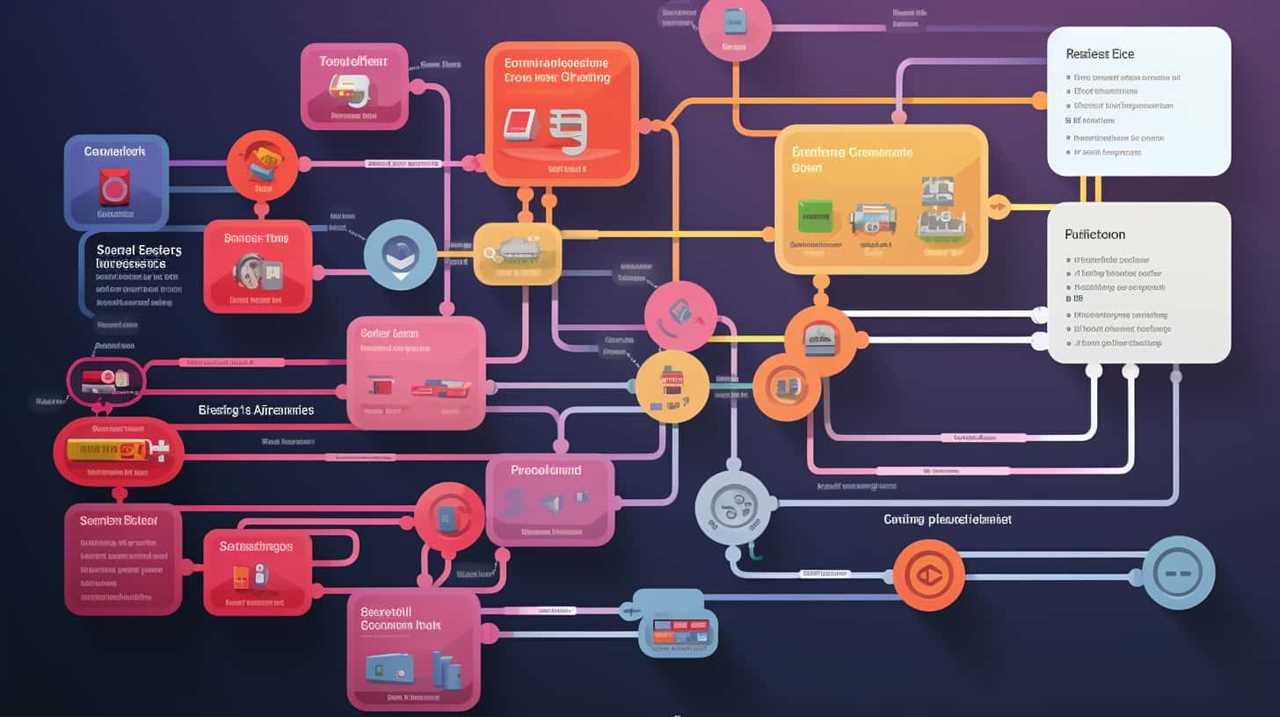Do you think of yourself as an expert in SEO? You might want to reconsider. We possess some insights that could grab your attention. Becoming proficient in content mastery is no easy task.
But fear not, because in this article, we’re going to share the best practices that will take your SEO skills to the next level.
From understanding user intent to optimizing on-page content, we’ve got you covered.
Get ready to master the art of SEO like never before. Let’s dive in!

Key Takeaways
- Understanding user intent is crucial for optimizing user experience.
- Conducting keyword research enhances understanding of user intent.
- On-page optimization enhances visibility and relevance of webpages.
- Building high-quality backlinks is crucial for improving search engine rankings and increasing organic traffic.
Understanding User Intent
To excel in content expertise, SEO pros must prioritize understanding user intent. User intent analysis is a crucial aspect of optimizing for user experience.
By analyzing user intent, we gain insights into what users are looking for when they conduct searches. This allows us to create content that aligns with their needs and provides value.
Optimizing for user experience involves understanding the different types of user intent, such as informational, navigational, and transactional. By tailoring our content to meet these specific intents, we can increase the chances of our website appearing in relevant search results.
Additionally, optimizing for user experience means ensuring our website is easy to navigate, loads quickly, and provides a seamless browsing experience.

Conducting Keyword Research
Now, let’s dive into conducting keyword research, a task that we frequently perform as SEO professionals to further enhance our understanding of user intent and optimize our content for maximum visibility and relevance. When conducting keyword research, it is crucial to explore search trends and identify long tail keywords that align with our target audience’s search behavior. By analyzing search trends, we can uncover valuable insights into the topics and keywords that are currently popular among users, allowing us to create content that meets their needs. Long tail keywords, on the other hand, offer a more specific and targeted approach, helping us attract highly relevant traffic to our website. By incorporating both of these strategies into our keyword research, we can ensure that our content is optimized for maximum visibility and relevance, ultimately driving more organic traffic to our site.
| Benefits of Exploring Search Trends | Advantages of Long Tail Keywords |
|---|---|
| – Stay updated with current user interests | – Less competition |
| – Identify emerging topics and keywords | – Higher conversion rates |
| – Gain insights into user behavior | – More targeted audience |
| – Create relevant and timely content | – Better user experience |
Optimizing On-Page Content
When optimizing on-page content, we focus on enhancing the visibility and relevance of our webpages to drive organic traffic and meet user needs.
One important aspect of on-page optimization is keyword density. We carefully analyze our content to ensure that keywords are used strategically and naturally throughout the page. Keyword stuffing isn’t effective and can even result in penalties from search engines.
Another crucial element is meta tags optimization. We optimize meta title tags and meta descriptions to accurately reflect the content of our webpages and entice users to click on our links in the search results.

Building High-Quality Backlinks
When it comes to SEO, building high-quality backlinks is crucial for success.
We need to focus on both the importance of backlinks and effective link building strategies.
It’s not just about the quantity of backlinks, but also the quality that matters.
Importance of Backlinks
Building high-quality backlinks is essential for improving search engine rankings and increasing organic traffic. Backlinks serve as a vote of confidence from other websites, indicating to search engines that your content is valuable and trustworthy. However, not all backlinks are created equal. It is crucial to focus on building high-quality backlinks that come from authoritative and relevant websites. These backlinks carry more weight and have a greater impact on your search engine rankings. Conducting backlink analysis can help you identify the quality and relevance of your existing backlinks, allowing you to make informed decisions about which ones to keep and which ones to disavow. By building high-quality backlinks, you can enhance your website’s visibility, credibility, and ultimately, drive more organic traffic.

| Importance of High-Quality Backlinks | |
|---|---|
| Improved search engine rankings | Increased organic traffic |
| Enhanced website credibility | Higher visibility |
| Greater trust from search engines | More targeted audience |
Link Building Strategies
To excel in content expertise, SEO pros employ effective link building strategies to create high-quality backlinks.
One of the most important strategies is conducting effective outreach to other websites and influencers in your industry. By reaching out to these individuals and offering valuable content or collaborations, you can secure high-quality backlinks that will boost your website’s authority and visibility in search engine rankings.
Another crucial aspect of link building is anchor text optimization. By strategically using relevant keywords in the anchor text of your backlinks, you can help search engines understand the context and relevance of your content. This can further enhance your website’s visibility and credibility.
However, it’s important to strike a balance between quality and quantity when building backlinks.

In the next section, we’ll explore the importance of prioritizing quality over quantity for long-term SEO success.
Quality Vs. Quantity
We prioritize building a select number of high-quality backlinks to ensure the success of our SEO strategy. In the world of SEO, it’s not just about the quantity of backlinks, but also about their quality. High-quality backlinks come from authoritative websites that have relevant, valuable content. These backlinks act as votes of confidence for our own website, signaling to search engines that our content is trustworthy and relevant.
When building backlinks, we focus on content depth and SEO effectiveness. Content depth refers to creating comprehensive, in-depth content that provides valuable information to our audience. SEO effectiveness involves optimizing our content and website to improve our search engine rankings.
Utilizing Structured Data Markup
When it comes to optimizing websites for search engines, utilizing structured data markup is key.

Structured data markup provides numerous benefits, such as enhancing the visibility and relevance of website content.
Benefits of Structured Data
Utilizing structured data markup brings significant advantages to our SEO strategy, enhancing website visibility and boosting organic rankings. By implementing structured data, we provide search engines with additional context about our content, making it easier for them to understand and index our webpages. This increased visibility leads to more organic traffic and higher search rankings.
One of the main benefits of structured data is the improved presentation of search results. By adding structured data markup, we can display rich snippets, knowledge graphs, and other enhanced search features, which make our listings more visually appealing and informative. This not only helps us stand out from the competition but also increases the likelihood of attracting clicks from users.
Additionally, structured data can help us target specific audiences and optimize our content for voice search. By marking up our pages with structured data, we can provide search engines with the necessary information to generate more accurate and relevant answers to voice queries. This ultimately improves the user experience and drives more targeted traffic to our website.

In summary, incorporating structured data markup into our SEO strategy has numerous benefits, including increasing visibility, improving search rankings, and enhancing the user experience. By leveraging structured data, we can optimize our content for search engines and gain a competitive edge in the digital landscape.
| Benefits of Structured Data |
|---|
| Enhanced website visibility |
| Boosted organic rankings |
| Improved search result presentation |
| Targeted audience optimization |
| Optimized content for voice search |
Implementing Structured Data
To effectively implement structured data markup, SEO pros should utilize a comprehensive strategy that incorporates quantifier determiners for improved search engine optimization.
Structured data implementation is crucial for optimizing search results and enhancing the visibility of web pages. By using structured data markup, SEO professionals can provide search engines with valuable information about the content on their websites. This helps search engines understand the context and relevance of the content, resulting in more accurate and targeted search results for users.
Best practices for structured data implementation include:

- Identifying the most relevant structured data types for your content
- Using proper schema markup
- Regularly monitoring and updating the structured data on your website.
SEO Impact of Markup
Implementing structured data markup has a significant impact on the SEO of a website. It not only helps search engines understand the content and context of a page but also improves the overall user experience.
One of the key SEO impacts of structured data markup is its contribution to mobile optimization. With the increasing number of users accessing websites on mobile devices, having structured data in place ensures that search engines can deliver the most relevant and user-friendly results.
Additionally, structured data markup can positively influence the page loading speed, which is another crucial factor for SEO. Optimized markup allows search engines to quickly crawl and index the website, resulting in faster loading times and better rankings.
Monitoring and Analyzing Performance
Our team’s approach to monitoring and analyzing performance is essential for optimizing our SEO strategies. By tracking metrics and conducting thorough performance analysis, we are able to identify areas of improvement and make data-driven decisions to enhance our website’s visibility and ranking. To effectively monitor and analyze performance, we utilize a combination of tools and techniques that provide valuable insights into the effectiveness of our SEO efforts. Here is an example of how we track and analyze performance:

| Metric | Tool Used | Analysis Method |
|---|---|---|
| Organic Traffic | Google Analytics | Measure the number of visitors from organic search |
| Keyword Rankings | SEMrush | Monitor keyword rankings and track changes over time |
| Backlinks | Ahrefs | Analyze the quality and quantity of backlinks |
| Page Load Speed | Google PageSpeed Insights | Identify areas for improvement in website speed |
Through careful tracking and analysis of these metrics, we are able to optimize our SEO strategies and ensure our website’s performance is consistently improving.
Frequently Asked Questions
How Can I Effectively Target User Intent in My SEO Strategy?
Improving our SEO strategy starts with understanding user intent. Targeting user intent is the key to SEO success. By aligning our content with what users are searching for, we can effectively engage and convert our audience.
What Are Some Advanced Keyword Research Techniques That Can Help Me Find Untapped Opportunities?
Advanced keyword analysis is crucial for finding untapped opportunities. By researching niche keywords, we can uncover hidden potential and boost our SEO strategy. Let’s explore some techniques that will help us excel in this area.
How Do I Optimize On-Page Content to Improve Search Engine Rankings?
To improve search engine rankings, we optimize on-page content using SEO strategies. This involves incorporating relevant keywords, optimizing meta tags, headers, and URLs, and ensuring high-quality, engaging content that satisfies user intent.

What Are the Most Effective Strategies for Building High-Quality Backlinks to My Website?
To build high-quality backlinks, we recommend utilizing guest blogging and influencer collaborations. These strategies can help increase your website’s visibility and credibility, ultimately improving your search engine rankings.
How Can Structured Data Markup Be Used to Enhance Search Engine Visibility and User Experience?
We’ve discovered that structured data markup is a game-changer for increasing user engagement and maximizing click through rates. It enhances search engine visibility and improves the overall user experience.
Conclusion
In conclusion, excelling in content expertise is crucial for SEO professionals to drive organic traffic and improve search engine rankings.
By understanding user intent and conducting thorough keyword research, optimizing on-page content, building high-quality backlinks, utilizing structured data markup, and continuously monitoring and analyzing performance, SEO pros can effectively enhance their website’s visibility and attract more targeted visitors.

Just like a well-tuned engine, a well-executed SEO strategy can propel your online presence forward, ensuring long-term success in the digital landscape.








